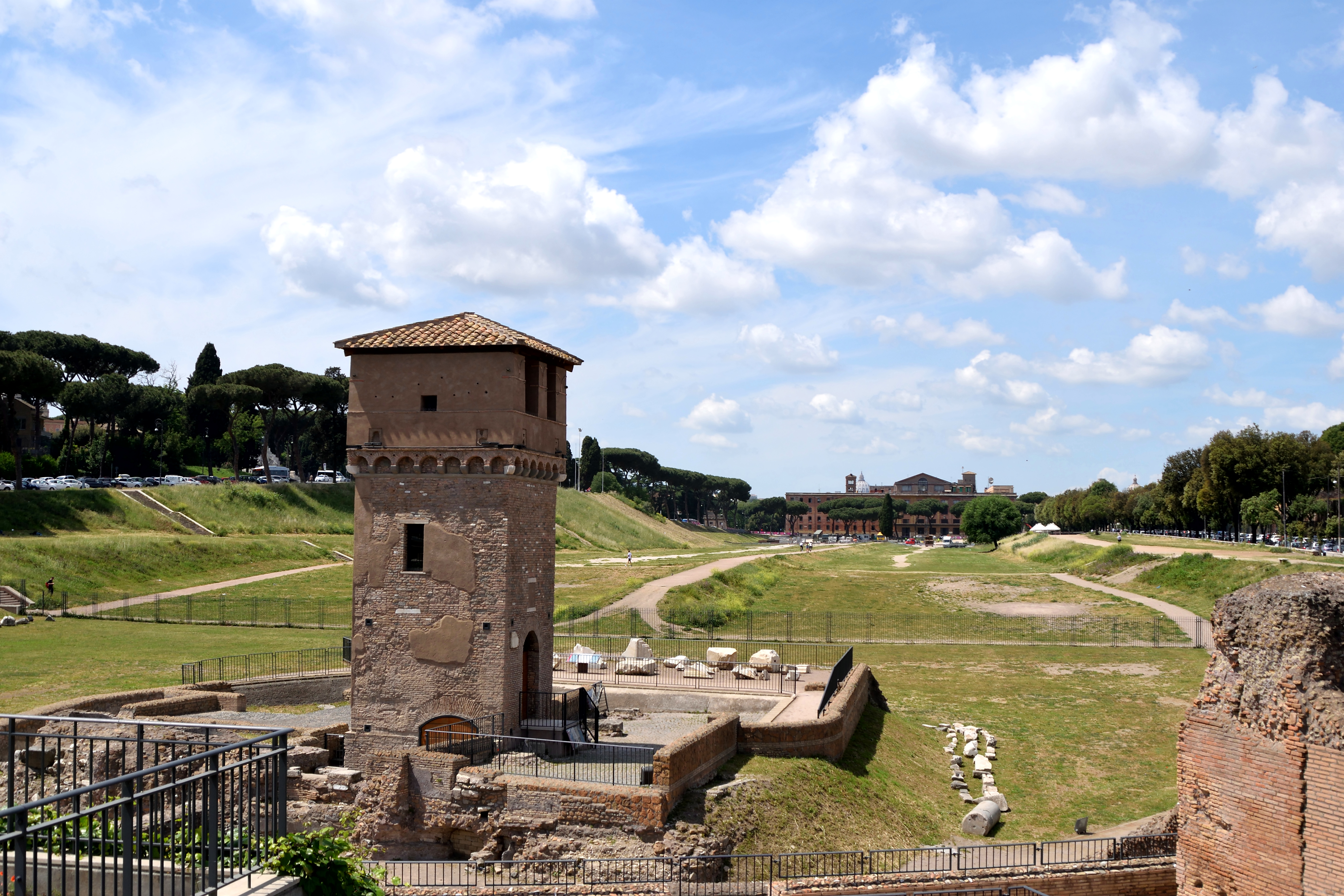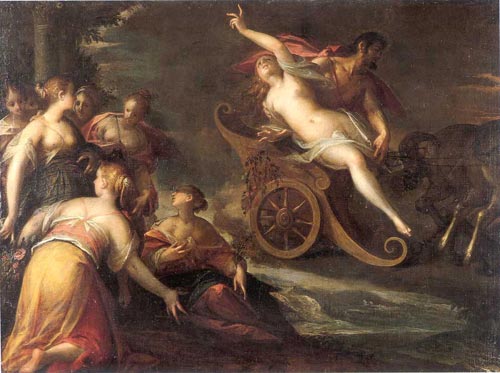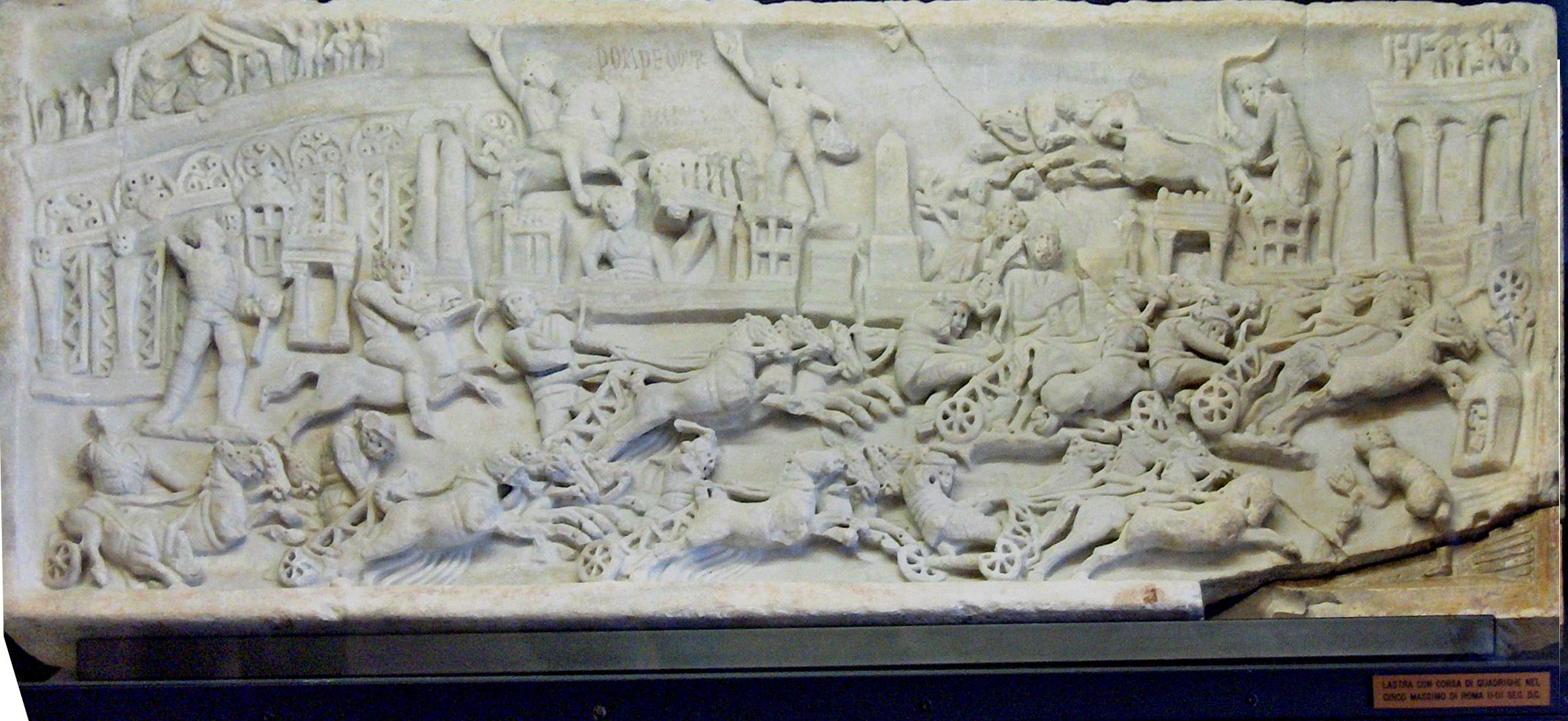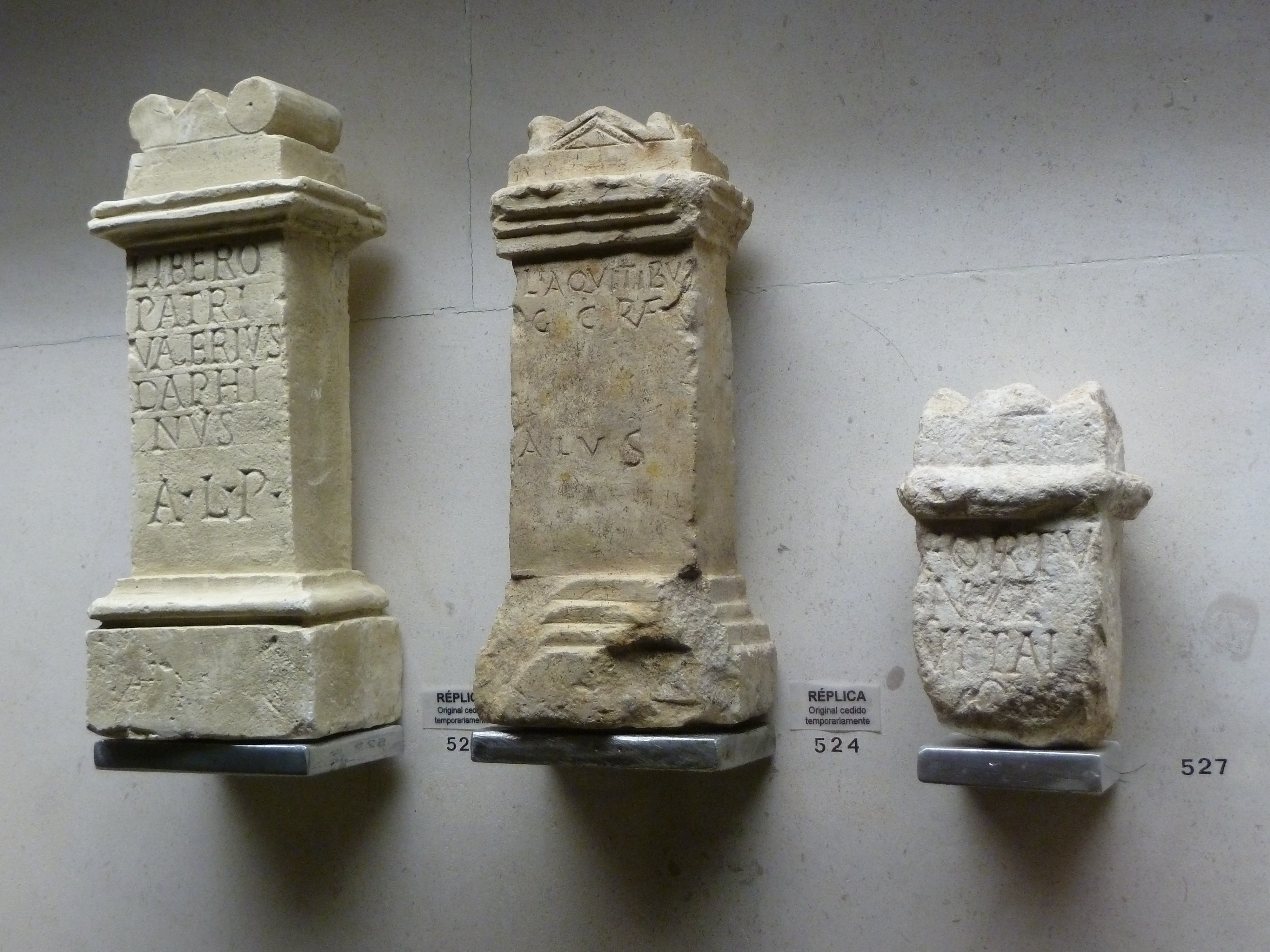|
Cerealia
In ancient Roman religion, the Cerealia was the major festival celebrated for the grain goddess Ceres. It was held for seven days from mid- to late April. Various agricultural festivals were held in the "last half of April". The Cerealia celebrated the harvest, and may have begun on the 19th. Surviving descriptions of Rome's city festival of Ceres are presumably urban versions of an originally rustic, agricultural festival. In his treatise on agriculture, Cato the Elder recommends that farmers sacrifice a sow (''porca praecidanea'') to Ceres, before the harvest. The Cerealia is listed on the oldest Roman calendars, and its institution in the city is attributed to the semi-legendary King Numa, in the earliest Regal period. The festival's archaic, agricultural nature is shown by a nighttime ritual described by Ovid. Blazing torches were tied to the tails of live foxes, who were released, possibly into the Circus Maximus. The origin and purpose of this ritual is unknown; it may ha ... [...More Info...] [...Related Items...] OR: [Wikipedia] [Google] [Baidu] [Amazon] |
Ceres (mythology)
In ancient Roman religion, Ceres ( , ) was a goddess of agriculture, grain crops, fertility and motherly relationships.Room, Adrian, ''Who's Who in Classical Mythology'', p. 89-90. NTC Publishing 1990. . She was originally the central deity in Rome's so-called plebeian or Aventine Triad, then was paired with her daughter Proserpina in what Romans described as "the Greek rites of Ceres". Her seven-day April festival of Cerealia included the popular '' Ludi Ceriales'' (Ceres' games). She was also honoured in the May lustration (''lustratio'') of the fields at the Ambarvalia festival: at harvesttime: and during Roman marriages and funeral rites. She is usually depicted as a mature woman. Ceres is the only one of Rome's many agricultural deities to be listed among the Dii Consentes, Rome's equivalent to the Twelve Olympians of Greek mythology. The Romans saw her as the counterpart of the Greek goddess Demeter,''Larousse Desk Reference Encyclopedia'', The Book People, Haydock, ... [...More Info...] [...Related Items...] OR: [Wikipedia] [Google] [Baidu] [Amazon] |
Circus Maximus
The Circus Maximus (Latin for "largest circus"; Italian language, Italian: ''Circo Massimo'') is an ancient Roman chariot racing, chariot-racing stadium and mass entertainment venue in Rome, Italy. In the valley between the Aventine Hill, Aventine and Palatine Hill, Palatine hills, it was the first and largest stadium in ancient Rome and its later Roman Empire, Empire. It measured in length and in width and could accommodate over 150,000 spectators. In its fully developed form, it became the model for Circus (building), circuses throughout the Roman Empire. The site is now a public park. Events and uses The Circus was Rome's largest venue for ''ludi'', public games connected to Religion in ancient Rome, Roman religious Roman festival, festivals. ''Ludi'' were sponsored by leading Romans or the Roman state for the benefit of the SPQR, Roman people (''populus Romanus'') and List of Roman deities, gods. Most were held annually or at annual intervals on the Roman calendar. Oth ... [...More Info...] [...Related Items...] OR: [Wikipedia] [Google] [Baidu] [Amazon] |
Roman Festivals
Festivals in ancient Rome were a very important part of Roman religious life during both the Republican and Imperial eras, and one of the primary features of the Roman calendar. ''Feriae'' ("holidays" in the sense of "holy days"; singular also ''feriae'' or ''dies ferialis'') were either public ''(publicae)'' or private ''( privatae)''. State holidays were celebrated by the Roman people and received public funding. Games ''(ludi)'', such as the Ludi Apollinares, were not technically ''feriae'', but the days on which they were celebrated were '' dies festi'', holidays in the modern sense of days off work. Although ''feriae'' were paid for by the state, ''ludi'' were often funded by wealthy individuals. ''Feriae privatae'' were holidays celebrated in honor of private individuals or by families. This article deals only with public holidays, including rites celebrated by the state priests of Rome at temples, as well as celebrations by neighborhoods, families, and friends held ... [...More Info...] [...Related Items...] OR: [Wikipedia] [Google] [Baidu] [Amazon] |
Proserpina
Proserpina ( ; ) or Proserpine ( ) is an ancient Roman goddess whose iconography, functions and myths are virtually identical to those of Greek Persephone. Proserpina replaced or was combined with the ancient Roman fertility goddess Libera, whose principal cult was housed in the Aventine temple of the grain-goddess Ceres, along with the wine god Liber. Each of these three deities occupied their own '' cella'' at the temple. Their cults were served or supervised by a male public priesthood. Ceres was by far the senior of the three, one of the '' Dii Consentes'', Rome's approximate equivalent to the Greek Twelve Olympians. She was identified with Greek Demeter and Liber was identified with Bacchus and Dionysus. Libera is sometimes described as a female version of Liber Pater, concerned with female fertility. Otherwise she is given no clear identity or mythology by Roman sources, and no Greek equivalent. Nothing is known of her native iconography: her name translates as a femin ... [...More Info...] [...Related Items...] OR: [Wikipedia] [Google] [Baidu] [Amazon] |
Ludi
''Ludi'' (Latin:games; plural of "ludus") were public games held for the benefit and entertainment of the Roman people (''populus Romanus''). ''Ludi'' were held in conjunction with, or sometimes as the major feature of, Roman religious festivals, and were also presented as part of the cult of state. The earliest ''ludi'' were horse races in the circus (''ludi circenses''). Animal exhibitions with mock hunts ('' venationes'') and theatrical performances (''ludi scaenici'') also became part of the festivals. Because some of these entertainments are not competitive "games", ''ludi'' may also be translated more generally as "shows". Days on which ''ludi'' were held were public holidays, and no business could be conducted—"remarkably," it has been noted, "considering that in the Imperial era more than 135 days might be spent at these entertainments" during the year. Although their entertainment value may have overshadowed religious sentiment at any given moment, even in lat ... [...More Info...] [...Related Items...] OR: [Wikipedia] [Google] [Baidu] [Amazon] |
Libera (mythology)
Proserpina ( ; ) or Proserpine ( ) is an ancient Roman goddess whose iconography, functions and myths are virtually identical to those of Greek Persephone. Proserpina replaced or was combined with the ancient Roman fertility goddess Libera, whose principal cult was housed in the Aventine temple of the grain-goddess Ceres, along with the wine god Liber. Each of these three deities occupied their own '' cella'' at the temple. Their cults were served or supervised by a male public priesthood. Ceres was by far the senior of the three, one of the ''Dii Consentes'', Rome's approximate equivalent to the Greek Twelve Olympians. She was identified with Greek Demeter and Liber was identified with Bacchus and Dionysus. Libera is sometimes described as a female version of Liber Pater, concerned with female fertility. Otherwise she is given no clear identity or mythology by Roman sources, and no Greek equivalent. Nothing is known of her native iconography: her name translates as a feminine ... [...More Info...] [...Related Items...] OR: [Wikipedia] [Google] [Baidu] [Amazon] |
April Observances
April is the fourth month of the year in the Gregorian and Julian calendars. Its length is 30 days. April is commonly associated with the season of spring in the Northern Hemisphere, and autumn in the Southern Hemisphere, where it is the seasonal equivalent to October in the Northern Hemisphere and vice versa. History The Romans gave this month the Latin name '' Aprilis''"April" in '' Chambers's Encyclopædia''. London: George Newnes, 1961, Vol. 1, p. 497. but the derivation of this name is uncertain. The traditional etymology is from the verb ''aperire'', "to open", in allusion to its being the season when trees and flowers begin to "open", which is supported by comparison with the modern Greek use of άνοιξη (''ánixi'') (opening) for spring. Since some of the Roman months were named in honor of divinities, and as April was sacred to the goddess Venus, her Veneralia being held on the first day, it has been suggested that Aprilis was originally her ... [...More Info...] [...Related Items...] OR: [Wikipedia] [Google] [Baidu] [Amazon] |
Barbette Spaeth
Barbette Stanley Spaeth is an American academic who is an associate professor at College of William and Mary, and is an expert in Roman mythology. She is past secretary of the Williamsburg Society, Archaeological Institute of America, and president of the Society for Ancient Mediterranean Religions. She graduated from Johns Hopkins University with a PhD. Spaeth wrote her doctoral dissertation on Ceres, ''The Roman Goddess Ceres''. She was a professor at Tulane University, from 1987 to 2001. She has won awards for her work in academia.See, ''e.g.''2011 Faculty Governance Awards at William and Mary College Selected publications *Spaeth, Barbette Stanley, "The Goddess Ceres and the Death of Tiberius Gracchus", ''Historia: Zeitschrift für Alte Geschichte,'' Vol. 39, No. 2, 1990. * See also * Aventine Triad * Cerealia * Crisis of the Roman Republic * Enna * Liber and Libera (mythology) * Mother goddess * Sexuality in ancient Rome * Women in ancient Rome Freeborn (Ancient Ro ... [...More Info...] [...Related Items...] OR: [Wikipedia] [Google] [Baidu] [Amazon] |
Roman Festival
Festivals in ancient Rome were a very important part of Roman religious life during both the Republican and Imperial eras, and one of the primary features of the Roman calendar. ''Feriae'' ("holidays" in the sense of "holy days"; singular also ''feriae'' or ''dies ferialis'') were either public ''(publicae)'' or private ''( privatae)''. State holidays were celebrated by the Roman people and received public funding. Games ''( ludi)'', such as the Ludi Apollinares, were not technically ''feriae'', but the days on which they were celebrated were '' dies festi'', holidays in the modern sense of days off work. Although ''feriae'' were paid for by the state, ''ludi'' were often funded by wealthy individuals. ''Feriae privatae'' were holidays celebrated in honor of private individuals or by families. This article deals only with public holidays, including rites celebrated by the state priests of Rome at temples, as well as celebrations by neighborhoods, families, and friends held ... [...More Info...] [...Related Items...] OR: [Wikipedia] [Google] [Baidu] [Amazon] |
Liber
In Religion in ancient Rome, ancient Roman religion and Roman mythology, mythology, Liber ( , ; "the free one"), also known as Liber Pater ("the free Father"), was a god of viticulture and wine, male fertility and freedom. He was a patron deity of Rome's plebeians and was part of their Aventine Triad. His festival of Liberalia (March 17) became associated with free speech and the rights attached to coming of age. His cult and functions were increasingly associated with Romanised forms of the Greek Dionysus/Bacchus, whose mythology he came to share. Etymology The name ''Līber'' ('free') stems from Proto-Italic language, Proto-Italic ''*leuþero'', and ultimately from Proto-Indo-European language, Proto-Indo-European ''*h₁leudʰero'' ('belonging to the people', hence 'free'). Origins and establishment Before his official adoption as a Roman deity, Liber was companion to two different goddesses in two separate, archaic Italian fertility cults; Ceres (Roman mythology), Cere ... [...More Info...] [...Related Items...] OR: [Wikipedia] [Google] [Baidu] [Amazon] |
Eleusinian Mysteries
The Eleusinian Mysteries () were initiations held every year for the Cult (religious practice), cult of Demeter and Persephone based at the Panhellenic Sanctuary of Eleusis in ancient Greece. They are considered the "most famous of the secret religious rites of ancient Greece". Their basis was a Bronze Age Agrarianism, agrarian cult, and there is some evidence that they were derived from the religious practices of the Mycenean Greece, Mycenean period.Dietrich (1975) ''The origins of Greek Religion''. Bristol Phoenix Press pp. 166, 167Walter Burkert. (1985)''Greek Religion''. Harvard University Press. p. 285 The Mysteries represented the myth of the Persephone#Abduction myth, abduction of Persephone from her mother Demeter by the king of the underworld Hades, in a cycle with three phases: the ''descent'' (loss), the ''search'', and the ''ascent'', with the main theme being the ''ascent'' () of Persephone and the reunion with her mother. It was a major festival during the Hellenistic ... [...More Info...] [...Related Items...] OR: [Wikipedia] [Google] [Baidu] [Amazon] |








